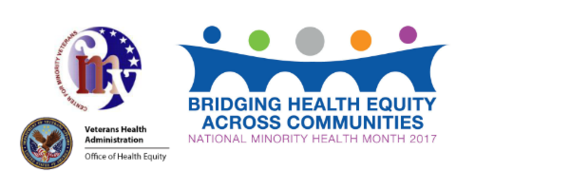 April’s Focus on Health Equity and Action Cyberseminar is dedicated to National Minority Health Month. The session will focus on minority Veteran’s military service history and use of VA benefits. Event description and registration information is below.
Military Service History and VA Benefit Utilization for Minority Veterans
Thursday, April 27, 2017
3:00 – 4:00 pm EST
Event
Description
VHA Office of Health Equity is pleased to
partner with the VA Center for
Minority Veterans for April’s session
in observation of National Minority Health Month. April’s Focus on Health
Equity and Action Cyberseminar session spotlights the recently released Minority Veterans
Report: Military Service History and VA Benefit Utilization Statistics report from the VA Data Governance and Analytics office.
This new report increases our understanding of racial and ethnic minority
Veterans, their use of VA benefits and services, as well as the impact of
military service on their lives post-military. April’s session will 1) discuss
the new report and the role of social and economic determinants of health; 2)
highlight VA actions to advance health equity for minority Veterans; and 3)
explore additional ways to best to serve these American Heroes.
Confirmed
Speakers
-
Tom
Garin, DPA
Director, Statistics and Analytics Service,
VA Office of Enterprise Integration, Washington, DC
-
Barbara
Ward, BSN, MPA
Director, VA Center for Minority Veterans,
Washington, DC
-
Uchenna
S. Uchendu, MD
Chief Officer, Office of Health Equity,
Washington, DC
-
Tamara
Lee, MS
Statistician, Statistics and Analytics
Service, VA Office of Enterprise Integration, Washington, DC
Background
Resources
Visit the Office of Health Equity website at http://www.va.gov/healthequity/ for more details about Veteran health equity issues, VA’s strategic plan to achieve health equity for Veterans (Health Equity Action Plan), and to learn more about the Focus on Health Equity and Action Cyberseminar series.

The VA Western New York Healthcare System kicked off their
inaugural Health Equity Day on
Tuesday, April 25, 2017. The event
was designed to raise awareness and bridge gaps in Veteran health care
disparities. The theme of the event was “Weaving
the Tapestry of Care” and featured workshops addressing issues of health
care disparities among vulnerable Veteran groups. The full day of free workshops were targeted to and attended by VA
health care professionals, Veterans, and community members.
According
to one of the organizers, Dr. Ursuline Bankhead, “Our goal is to learn and share
best practices from VA and community leaders specifically to address health
care disparities. Addressing the impact of population differences can improve
the overall health outcomes for each individual patient.” Dr. Uchenna S.
Uchendu, OHE Chief Officer, delivered a video keynote and the event was covered
in the local newspaper, The Buffalo Times.
|

“May
is #MentalHealthAwarenessMonth. #UseYourVoice to spread the word and support
our Nation's #Veterans: http://thndr.me/CYbrdK”
May is
Mental Health Awareness Month. The Office of Health Equity is pleased to
partner with VA’s Make the Connection campaign to raise
awareness of mental health, effective treatments, and efforts to support those
who face mental health challenges.
VA’s Make the Connection campaign encourages Veterans, Servicemembers, and their
families to connect with local sources of mental health support when they need
them. Here is how you can get involved.
-
Veterans
and their supporters can do this through the interactive website, MaketheConnection.net which features
information about symptoms, conditions, and treatment options along with
hundreds of Veterans’ stories of strength and recovery. These powerful,
personal stories are the heart of VA’s efforts to demonstrate that treatment
works and that recovery is possible.
-
Thunderclap: Your Facebook page
can participate in a nationwide call to action across social media by using the
Thunderclap platform, releasing to all your fans a message that helps VA raise
awareness. A Thunderclap is a synchronized, global release to fans of all the
organizations and users that sign up to participate, creating tremendous social
media buzz. This activity is approved by VHA Communications and VA’s Office of
Public Affairs. Don’t miss this opportunity to support Veterans and the
positive mental health narrative that VA is creating. Sign up for the
release on May 1 and learn more.
Did you
know that in the United States suicide is the 10th leading cause of death?
Suicide
prevention is a major priority for the Department of Veterans Affairs. The VHA Office of Health Equity (OHE) is helping to bring
awareness of suicide risk and prevalence among Veterans. Some populations of
Veterans may be at increased risk.
Here is a recent article that OHE is pleased
to share in order to raise awareness of this very important issue.
Population Mental Health among U.S. Military Veterans: Results
of the Veterans Health Module of the Behavioral Risk Factor Surveillance
System, 2011–2012
John R.
Blosnich, PhD; MPH, Lisa A. Brenner, PhD; and Robert M. Bossarte, PhD
Purpose: To examine mental health indicators,
in aggregate and stratified by sex, among a population-based sample of U.S.
military veterans.
Methods: Data are from veteran who completed
the Veterans Health Module (VHM) of the 2011 and 2012 Behavioral Risk Factor
Surveillance System (n = 10,406). VHM items included lifetime diagnoses of
mental illnesses, service in a combat zone, sources of mental health care, and
past 12-month suicidal ideation and attempt. We used weighted, multiple
logistic regression models, adjusted for sociodemographics, to examine
differences in suicidal ideation and attempt among men and women.
Results: Overall, 5.0% of the sample reported
recent suicidal ideation and 1.0% reported attempting suicide. Among men,
unemployment was positively associated with suicidal ideation, and combat
exposure was negatively associated with suicidal ideation. Being separated,
divorced, or widowed was positively associated with suicidal ideation among
women. After adjusting for sociodemographic and VHM variables, veterans who
sought mental health treatment from both Veterans Affairs (VA) and non-VA
facilities had more than fourfold increased odds of suicidal ideation than
veteran who sought mental health treatment from only VA facilities (adjusted
odds ratio = 4.02; 95% confidence interval 1.23–13.13).
Conclusions: Correlates of
suicidal ideation differ between male and female veterans. Veterans who use
both non-VA and VA facilities for mental health services may have greater risk
of self-directed violence.
Citation: Blosnich, J.R., Brenner, L.A. and
Bossarte, R.M. (2016). Population mental health among US military veterans: Results
of the Veterans Health Module of the Behavioral Risk Factor Surveillance
System, 2011–2012. Annals of Epidemiology,
26(8), pp.592-596. Available online at http://www.sciencedirect.com/science/article/pii/S1047279716301685.
|